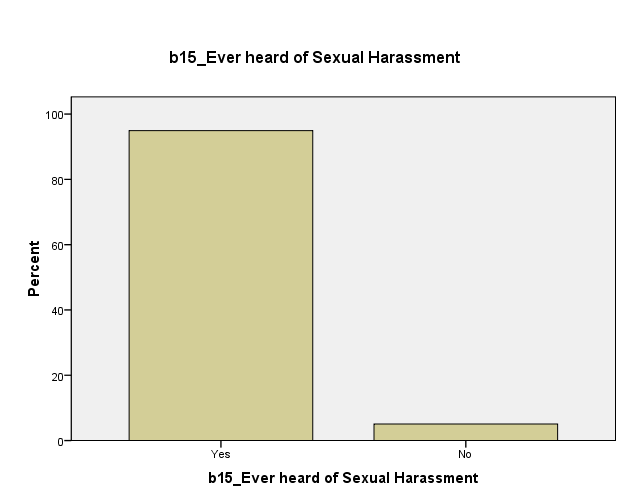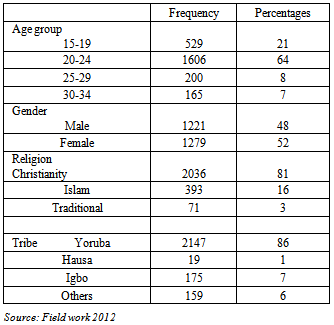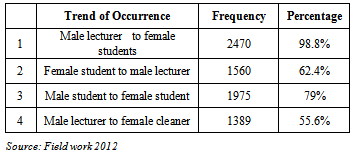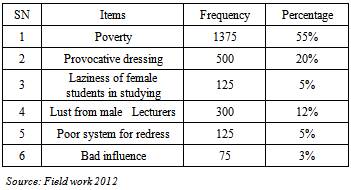-
Paper Information
- Next Paper
- Previous Paper
- Paper Submission
-
Journal Information
- About This Journal
- Editorial Board
- Current Issue
- Archive
- Author Guidelines
- Contact Us
International Journal of Applied Psychology
p-ISSN: 2168-5010 e-ISSN: 2168-5029
2014; 4(1): 13-18
doi:10.5923/j.ijap.20140401.02
Sexual Harassment and Psychological Consequence among Students in Higher Education Institution in Osun State, Nigeria
Taiwo M. O1, Omole O. C2, Omole O. E2
1Center for Gender and Social Policy Studies, Obafemi Awolowo University, Ile-Ife, Nigeria
2Department of Psychology, Obafemi Awolowo University, Ile-Ife, Nigeria
Correspondence to: Taiwo M. O, Center for Gender and Social Policy Studies, Obafemi Awolowo University, Ile-Ife, Nigeria.
| Email: |  |
Copyright © 2012 Scientific & Academic Publishing. All Rights Reserved.
This study investigated the occurrence of sexual harassment and its psychological implication among students in five higher education Institutions in South West, Nigeria. A total number of 2500 (M=1221, F=1279) students selected through systematic sampling participated in across-sectional survey that used semi-structured, self-administered questionnaire in September 2012. Respondents’ average age is 22 years with high knowledge and awareness of incidences of sexual harassment (97%) that fails to translate into behaviour change, as sexual harassment continues unchecked. Significant trend of sexual harassment occurrence is from a male lecturer to a female student (98.8%). Poverty and negative peer influence are also key drivers of sexual harassment in higher educational institutions. Fear and trauma were rated highest as the psychological consequences of sexual harassment on the victims. This phenomenon has grave implication both for the individuals, higher education institutions and the labour market in Nigeria. Hence, the need to develop sustainable systems and structures for redress through development of anti-sexual harassment policies, well-equipped security unit, establishment of telephone hotlines and well trained school counselors to effectively handle cases of sexual harassment and secure justice for the victims.
Keywords: Sexual harassment, Higher education institutions, Sexual behaviour, Sexual overture, Sexual assault
Cite this paper: Taiwo M. O, Omole O. C, Omole O. E, Sexual Harassment and Psychological Consequence among Students in Higher Education Institution in Osun State, Nigeria, International Journal of Applied Psychology, Vol. 4 No. 1, 2014, pp. 13-18. doi: 10.5923/j.ijap.20140401.02.
Article Outline
1. Introduction
- In every human society where there is interaction between opposite sex, some levels of sexual attraction is expected. When this occurs, mutual interest and reciprocal response defines a civilized and socially acceptable sexual behaviour. However, the increasing manifestation of social vices in higher institutions in Nigeria can be attributed to the poor quality of graduates being produced. One of such is sexual harassment that has continued to attract the attention of researchers and the media as a common phenomenon in the Higher education Institutions. This abnormal, antisocial behaviour has been accepted as a norm within the higher education institutions Nigeria and overseas. Previous studies on this subject have provided various definitions of sexual harassment. Sexualharassment is definedas unsolicited, unwelcome and unreciprocated sexual overture from a person to elicit unwanted sexual relations from another person[2]. This includes any inappropriate sexual overture, subtle and unsubtle persistent behaviour, assault and actual sexual abuse that may be expressed physically, verbally or non-verbally, usually from someonewith a higher power or at a vantage position to less a privileged person. Sexualharassment in schools has also been described as an unwelcome behavior of a sexual nature that makes you feel uncomfortable, fearful or powerless, and interferes with your schoolwork[12].Sexual harassment is a global issue that has permeated the fabrics of higher education institutions and many workplaces as long as humans (males and females) have reasons to interact. Sexual harassment in universities and other higher education institutions is not limited to Africa[10]. Asa global challenge, sexual harassment deservesto be mainstreamed into academic curriculum, particularly for reducing vulnerability among students and increasing access to restorative care of victims. Universities in Ghana and Tanzania have already integrated sexual harassment into course modules on Gender, Power and Sex to address the challenge ofmale lecturers demanding sex from female students in exchange for grades as a right.A study among psychology students in the US revealed a higher prevalence of sexual harassment and unethical intimacy between postgraduate students and their supervisors than undergraduate students due to frequent face-to-face interaction when seeking advice on their research studies[8]. Higher education institutions in Nigeria are not left out of this saga, for instance, it has been affirmed that, in Nigeria sex for grades in the tertiary institutions is a reality and the male lecturers in particular, perceived themselves as thin gods and such unprofessional behaviour can be perpetuated unchecked[6, 9]. A similar study[1] reported a high prevalence of sexual harassment both in the education institution and in the workplace. Sexual harassment takes on various trends and nature, but most importantly, it emanates from unequal power relation that is also associated with gender based violence and violation of human rights. In most cases, the harasser is usually older, powerful and poses something of value that is beneficial to the harassed[14].The trend of occurrence was reported totake several forms: from male lecturer to female student, from male students to female students, from male lecturers to female lecturers and non-academic staff and so on. In most cases, female students are most at risk as victims while the male lecturers are more likely to be the perpetuators[3]. This trend presents an amazing and disturbing scene in an environment that is often believed to be a center of excellence for molding and developing virile leadership skills, high moral qualities and intellectual capacityfor human capital for future leadership.A number of factors have been enumerated as motivation for perpetuation of sexual harassment to include: lust, pursuit of happiness, lack of norm of morality, lack of conscience, pursuit of pleasure, lack of temperance, passion, habit, value, personality disorder, inferiority complex, immaturity, cheapness, abuse of power, and suffering from demonology [11]. In addition, indecent dressing pattern among female students who almost go naked in their appearance can also be driving factors for continued incidence of sexual harassment. Many female students are so morally bankrupt that they rely absolutely on their womanhood for high grades without due preparation.
2. Psychological Impact of Sexual Harassment
- Sexual harassment is often associated with assault, bullying, coercion, discrimination, favoritism; exploitation and intimidation as vices that play out in the sexual encounter leaving the victims with long-term pains that devastate their psychological well-being. Incidence of sexual harassment is not always reported and perpetrators are allowed to go free. This could be responsible for the unchecked reoccurrence of the behaviour deficit. Sexually harassed individuals can suffer through a number of psychological effects ranging from irritation and frustration to anxiety, stress, and trauma. Depending on the situation, a victim can experience anything from mild annoyance to extreme psychological damage, while the impact on a victim's career and life may be significant and also leave them in ruins.There are many physical and psychological reactions in response to discriminatory experiences. These include gastrointestinal disorders, jaw tightening, teeth grinding, dizziness, nausea, diarrhea, tics, muscle spasms, fatigue, dyspepsia, neck pain, back pain, pulse changes, headaches, weight loss, weight gain, increased perspiration, cold feet and hands, loss of appetite, binge eating, decreased libido, delayed recovery from illness, sleep disruption, increased respiratory or urinary tract infections, recurrences of chronic illnesses, ulcers, irritable bowel syndrome, migraines, eczema and urticarial[4, 7, 13]. Other psychological symptoms of sexual harassment could be persistent sadness, negative outlook, irritability, mood swings, impulsivity, emotional flooding, anxiety, fears of loss of control, excessive guilt and shame, escape fantasies, compulsive thoughts, rage episodes, obsessional fears, crying spells, persistent anger and fear, decreased self-esteem, self-doubt, diminished self-confidence, decreased concentration, feelings of humiliation, helplessness, vulnerability and alienation. Psychiatric disorders reported have included anxiety disorders, post-traumatic stress disorder, acute stress disorder, dissociation disorders, somatization disorders, sleep disorders, sexual dysfunction disorders, psychoactive substance abuse disorders, depressive disorders and adjustment disorders[13]. General stress process model posits that the frequency and severity of harassment are key predictors of mental health and well-being and that personal vulnerability moderates the association between harassment and its’ negative outcomes.Sexual harassment undermines the integrity of the academic environment, and it prevents its victims from achieving their full potential. For instance, graduates with certificates obtained through favours or sexual consent are not worth the certificates they have been conferred. This is clearly demonstrated in the performance of the half-baked graduates produced into the labour market in recent times. Many seasoned lecturers and researchers in whom much resources of the nation have been expended have been lost and their careers terminated through cases of sexual harassment. The image of those involved in sexual harassment and those of their family members are often tarnished within the immediate environment. In most cases the consequences for female victims can be reflected in psychological pains, revulsion, or hatred towards the harasser or other men, victims often feel cheap, dirty and vulnerable. In the same vein, sexual harassment can threaten a student’s physical and emotional well-being, influence how well a student perform in school, and make it difficult for the student to achieve her career goals. In addition, the memory hardly fades away rather; it continues to trigger a feeling of depression that can make the victim develop a withdrawal syndrome particularly from men with long-term impact on decision to be married. The impact of sexual harassment on a student’s educational progress and attainment of future goals can be significant and should not be underestimated. As a result of sexual harassment, a student may have trouble in learning or drop out of school, lose trust in school officials, become isolated, nurse constant fear for personal safety and have low self-esteem which may prevent the student from achieving her maximum potential. By extension, sexual harassment negatively impacts on the national productivity and economic development due to poorly skilled employees who creates problems for the labour market. It has been observed that those who have been harassed before may react more negatively to harassment than first-time targets because past experience diminishes one’s ability to cope[5].
3. Objectives
- v To determine the Nature and Trend of Sexual Harassment among Students in Higher Education in Nigeria v To ascertain the causes of Sexual Harassment as perceived by students in higher Education Institution v To examine the Psychological Consequences of Sexual Harassment on the victims v To recommend possible institutional response to control occurrence of sexual harassment in higher education institution
4. Methodology
4.1. Research Design
- A cross-sectional study that used random sampling technique to select 2500 students was carried out in five higher education institutions in Nigeria. This design allowed the researcher to establish the occurrence of sexual coercion, its nature and trend, perceived causes and possible consequences on the victims.
4.2. Population and Samples
- The study population comprised of the student body across various faculties including Arts; Administration; Education; Engineering; Clinical Science; Health Sciences; Law; Social Science;Technology and Agriculture in the selected higher institutions in Osun state. A multi-stage random sampling method was used in selecting the samples for this study. Five out of Ten government and Private higher education institutions in the state were selected. Fifty students each were selected from ten faculties/ colleges/ course of study to make 500 students from each institution. Overall a total of 2500 students who consented participated in the study.
4.3. Instrument
- A self-developed, well-structured questionnaire with six themes and seven items per theme was administered on the respondents. The themes include: Socio-demographic information, awareness of incidence of sexual harassment, trend of occurrence of sexual harassment, causes of sexual harassment, level of acceptance and reporting of sexual harassment and perceived psychological consequences of sexual harassment. The instrument was validated through a test-re-test method. A Cronbach’s Alpha result yielded a validity of r=0.79, which was sufficient for administration.
5. Results
5.1. Socio-Demographic Characteristics of Participants
 | Chart 1. Showing Respondents’Awareness of Sexual Harassment |
|
|
|
|
6. Level of Acceptance of Sexual Overtures by Victims and Reporting System
- Respondents reported two categories of unwillingness in accepting sexual overtures: (A) unwilling acceptance based on the promise to increase score or grades (45%); money or gifts (10%); pressure through text messages (15%); & unwanted jeers/comments (30%).(B) Forced or coerced to accept due to threats of failure (50%); gang rape(35%) and influence of bad friends (15%). A substantial proportion of respondents (80%) feel comfortable to disclosure experience of sexual harassment to their trusted friends and confidants rather than parents/ guidance or the school authority. The majority (95%) of respondents however are willing to report to the security unit and the school counselors if they were assured of confidentiality of their identity.
7. Discussion
- This study has established additional evidence on the occurrence of sexual harassment in higher education institutions in Nigeria. The high level of awareness of the occurrence of sexual harassment did not translate into a change in behaviour for the perpetrators. Many of the cases of sexual harassment go unpunished and the victims are left to deal with the trauma, which stay with many of them for a long period and sometimes relapses into a psychological condition and mental health challenge. This has negative effect on the academic achievement and future sexual relationship particularly in the case of rape. The most common trend of sexual harassment in the higher educational institutions is sexual advances from male lecturers to female students confirming the unequal power relations where the perpetrator occupies a higher and influential position of authority over the victim as affirmed by previous study[14]. There are also incidences of sexual harassment from male students to female students and some extreme cases of rape where the female student refuses to respond to initial advances. This is also a manifestation of unequal power relation and a gender based violence that impacts negatively onhuman rights. Some female students who are lazy in their studies sometimes motivate the male lecturers into an unethical relationship with a view to ‘’use what they have to get what they want’’, which is a common slogan among such female students who will not attend classes, sit for any form of assessment and would desire to pass their examinations.Poverty has also been implicated as the major reason for many females yielding to sexual advances even when they are dissatisfied with suchactions. This also has a direct link with influence of bad friends who motivates them to engage in unholy actions in order to belong to a particular social class their parents cannot afford. Most female students from poor background who have not developed clear values and future goals are particular target of negative peer influence. Another main reason for a continued perpetuation of sexual harassment is the weak system of redress in the higher education institutions.Many victims are not confident to report incidences due to lack of confidence in the institutional structures. There is no hope that perpetrators will be punished and victims will get justice. However, victims are willing to report to trusted friends, school security and school counselor. This justifies the need for Higher education institution to provide functional counseling and restorative therapy within the school system in order to provide prompt attention to cases of sexual harassment.
8. Conclusions and Recommendations
- Sexual harassment is described as a common phenomenon that continues unchecked in the higher education institutions in Nigeria. Female students have greater vulnerabilities to unwelcome sexual advances from Lecturers or officials in position of authority. Many poor students who are also negatively influenced by peers are prepared to offer their bodies in exchange for scores in their examinations. Cases of rape continue to flood the pages of the newspaper on a daily basis yet without any active response for redress. Existing structures are not sufficiently equipped to address issues relating with sexual harassment. The overall effect of these issues manifest in increased school drop-out, low skilled graduate, low productivity, aggression, mal-adjusted young adults who are not capable of contributing to national socio-economic development of Nigeria. The implication of losing great potentials that should occupy strategic leadership position in national life is grave for Nigeria among the committee of Nations, especially with the desire to attain MDGs, VISION 20:20 and the transformative agenda.In view of the above, higher education institution in Nigeria need to develop a sustainable system of redress for this act of indiscipline. The authority need to develop and mainstream Anti-sexual harassment policies into the system of operation. Thesecurity unit in the higher institutions should be well equipped for rapid response; the school counselors should be trained and skilled to handle cases of sexual harassment effectively, telephone hotlines should also be made available to all students within and outside the campus. Dress codes should be enforced, team teaching should be encouraged and appropriate disciplinary action should be taken against perpetrators and justice secured for the victims.
 Abstract
Abstract Reference
Reference Full-Text PDF
Full-Text PDF Full-text HTML
Full-text HTML


